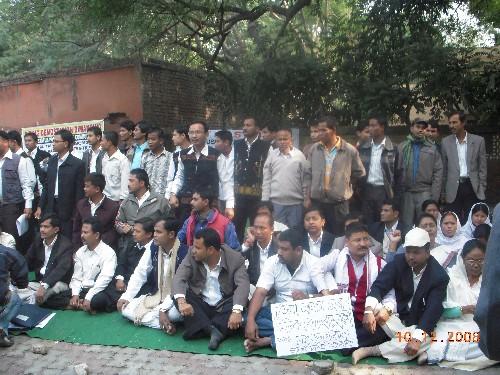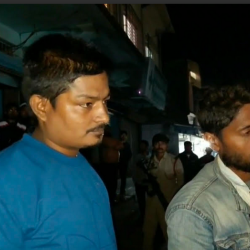Dharna by Assam communities in Delhi
Six indigenous ethnic communities from Assam namely Chutiyas, Tai Ahom. Motok, Moran, Koch Rajbangshis and Tea Tribes have staged dharna at Jantar Mantar, coinciding the inaugural day of the Winter session of Parliament on December 9, 2009. They shouted slogans againat the apathy of the government in tabling the bill to grant ST status to these 6 communities.
Other Contents by Author
Growing up, Bhupen Hazarika’s songs were the rhythm of our lives. His music was everywhere—woven into celebrations, quiet evenings, and moments of reflection. Whenever he needed a song, he’d simply write a poem and set it to music. Just like that, something timeless was born.
I wasn’t alone in admiring him. He had millions of fans across the globe. I.P. Hazarika, former CMD of MMTC, once told me he met Bhupenda’s admirers deep in the Congo, Africa where he went to buy Diamonds.. That’s the kind of reach his voice had—universal, magnetic.
Bhupenda could’ve chosen a life of comfort. He earned a PhD from Columbia University and married Priyambada, niece of then RBI Governor and Finance...
Bandh is a form of protest used by political activists or aggrieving organizations in South Asian countries such as India, Bangladesh, Pakistan, Sri Lanka and Nepal. It is similar to a General Strike. During a bandh, a political party or a community declares a general strike, for example An Assam bandh is a call for a bandh across Assam and a bandh can also be called within a smaller area, say Moran bandh or a district, say Tinsukia bandh.
During the period of bandh, which can be 12 Hrs, 24 Hrs, 48 Hrs or few days long the student/community organisation or political party declaring a bandh expects the general public to stay at home, cease regular work and not attend office. Shopkeepers...
Indrajit Narayan Dev is the 14th generation of the chronological lineage of the erstwhile Koch Dynasty from the days of the great Koch King Maharaja Naranarayan & his General brother Chilarai, of the then 16th century Assam. He dwells atop the ancestral bungalow, the “Little Hillock”, overlooking the sprawling 30 bighas (1 bigha = 1600 sqyd) estate of Ranibagan situated at Beltola Tiniali in the metropolitan city of Guwahati, in the state of Assam, a serene environment amidst the crowd.The estate has a collection of numerous fruit, flower bearing trees and plants and a host of varied species of other valuable trees too. Within the contour terrain, an approximately 5 bighas (...
Partition brings pain and trauma. If it is international like the partition of India, then it’s tragic yet unavoidable. But when that happens within the country it’s regrettable. I have no idea about the way the boundary between Assam and Nagaland was determined. When Nagaland was carved out of Assam, I was in primary school and one fine day we got a day off to celebrate the occasion of division of Assam or to say the birth of the new sister state of Nagaland.Dimapur was the ancient capital of the Dimasa Kachari Kingdom. The ruins of that time are scattered all around. From Dimapur till North Cachar, a huge tract is inhabited by Dimasas. Dimasa Kacharis have own language and now they have a...
My contact with Rajib Bora is one and half decades long. He organised Majuli Utsav in Majuli around ’97 and subsequently, we did a Majuli Festival in Dilli Haat in 2004. I was that time the General Secretary of Assam Association, Delhi. We introduced apong (rice beer of the Mising community) to Delhi people. Needless to say, there was a serpentine queue to have a cup of the brew.
Rajib Bora
Over time our relations grew. Rajib tried his hands in many things. A dreamer and creative guy; I could sense the restlessness in his mind. I used to tell him that his millions lie in food.
Last year around this time Suresh (Suresh Ranjan Goduka) of Jeevan Initiative, of which I happen...
Assam Association, Delhi celebrated Magh Bihu, the harvest festival of Assam, which marks the end of the harvesting season, and ushering in of the Spring, with a day long programme at the Central Civil Secretariat Sports Ground, Chanakyapuri, New Delhi today.
The celebrations started with a welcome address by Justice(Retd) Dr. Mukundakam Sharma, President, Assam Association, Delhi. It was followed by the flag hosting & the lighting of the ‘Meji’- the traditional bonfire in the gracious presence of eminent personalities like Dr. Yoganand Shastri, Speaker of Delhi Assembly.
As part of the day-long programme, drawing and painting competition was organized among the children....
Bitten by the annual spring fever and the romance of the season, the Assamese community, spread all over the National Capital Territory of Delhi (NCR) gathered in large numbers with their families and friends at the Indira Gandhi National Centre for the Arts (IGNCA) grounds to celebrate the mother of all Bihu celebrations on 24th April 2011. The excitement on the ground of IGNCA was palpable as 3 to 4 thousand Assamese people met each other and exchanged pleasantries.
The venue, courtesy IGNCA, is part of its policy to promote the rich cultural heritage of the North East. IGNCA located near the India Gate and at stone's throw distance from the power corridors of the National Capital...
The grand old organization of the Assamese community living in Delhi, the Assam Association, Delhi celebrated ‘goru bihu’ with gusto and fervour, only missing point was the worshipping of the holy cow, which was not possible in a metro city life. It was an evening of coming together of the community to celebrate the spring festival to reconnect with life left behind in Assam and to teach the young city bred generation, about the social capital of the community and the traditional values and cultural heritage.
The cultural nerve centre- Srimanta Sankaradeva Bhawan was abuzz with the sound of ‘dhol-taal’, ‘penpa’, ‘gogona’, ‘hutuli...
It was a journey down the memory lane for generations of ex-Cottonians living in the Delhi and National Capital Region (NCR) comprising NOIDA, Ghaziabad, Gurgaon and Faridabad when alumni from 67 batches gathered in the heart of New Delhi on Sunday to recollect their golden memories of Cotton College and do some brainstorming on how they can give back something to their alma mater.
The alumni of Cotton College in the national capital had last met in 1999, just as the college was preparing to celebrate its centenary in 2001, but somehow after that they had never managed to gather together again.
But this year, thanks to the initiative taken by Delhi-based Cottonians mainly; Manoj Kr...
The members of Ahom community in Delhi observed Me-dam-me-fi in the National capital with traditional Tai-Ahom worshiping of the Ancestors. The Bailung, priest of the tai-Ahom community, performed the age-old ritual of remembering the forefathers for peace in the land, prosperity of the inhabitants.
A large number of participants joined the function despite a very short notice of two days. It was also an occasion for non-Ahom associates also to have a peek into the traditional Tai-Ahom culture. The function ended with a grand feast. A committee was formed to observe the function annually with Gauri Kanta Handique as the President.









Add new comment